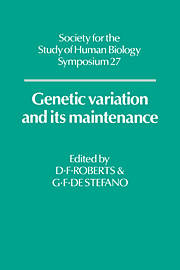Book contents
- Frontmatter
- Contents
- Preface
- Part I Genetic Diversity - Its Dimensions
- Genetic polymorphisms - a widening panorama
- Some implications of improved electrophoresis techniques for population genetics
- HLA variation in the tropics
- Chromosome polymorphism in humans
- Restriction fragment length polymorphisms in the human genome
- Nucleotide sequences, restriction maps, and human mitochondrial DNA diversity
- Mitochondrial DNA variation in eastern highlanders of Papua New Guinea
- The Contribution of polymorphisms in mtDNA to population genetic studies
- Part II Genetic Diversity - Its Origin and Maintenance
- GENETIC DIVERSITY - APPLICATIONS AND PROBLEMS OF COMPLEX CHARACTERS
- Index
Some implications of improved electrophoresis techniques for population genetics
Published online by Cambridge University Press: 05 March 2012
- Frontmatter
- Contents
- Preface
- Part I Genetic Diversity - Its Dimensions
- Genetic polymorphisms - a widening panorama
- Some implications of improved electrophoresis techniques for population genetics
- HLA variation in the tropics
- Chromosome polymorphism in humans
- Restriction fragment length polymorphisms in the human genome
- Nucleotide sequences, restriction maps, and human mitochondrial DNA diversity
- Mitochondrial DNA variation in eastern highlanders of Papua New Guinea
- The Contribution of polymorphisms in mtDNA to population genetic studies
- Part II Genetic Diversity - Its Origin and Maintenance
- GENETIC DIVERSITY - APPLICATIONS AND PROBLEMS OF COMPLEX CHARACTERS
- Index
Summary
INTRODUCTION
The contributions made by knowledge of the human blood groups to fundamental genetics and to the nature and pattern of population variation were enormous. Today over 160 red cell antigens are known, and data on the distribution of their frequencies in various populations of the world were collated by Mourant et al (1954, 1976), and brought up to date by Tills et al (1983). But the greatest advances in population genetics in the last few decades came as a result of the development of methods to identify genes governing other variables such as enzymes and proteins involved in fundamental biological functions in the body. Many enzymes and proteins were found to exist in more than one molecular form. Those multiple forms of proteins arising from genetically determined differences in their primary structure are now termed isozymes or isoenzymes (IUB, 1972). The study of the genetic heterogeneity of isozymes was facilitated by the techniques of electrophoresis. Tiselius (1937) developed this technique as moving boundary electrophoresis, but its first direct application to characterise human gene products was by Pauling and his colleagues (1949) who differentiated by zone electrophoresis the product of the mutant hemoglobin gene for sickle cell (HbS) from normal hemoglobin (HbA). This was a crucial discovery, because it meant that the heterozygote and homozygote could be identified directly by an experimental technique, electrophoresis. In the 1950's the technique of zone electrophoresis was perfected by exploration and development of a variety of supporting media such as agarose, cellulose acetate, starch and polyacrylamide.
- Type
- Chapter
- Information
- Genetic Variation and its Maintenance , pp. 11 - 28Publisher: Cambridge University PressPrint publication year: 1986
- 1
- Cited by

